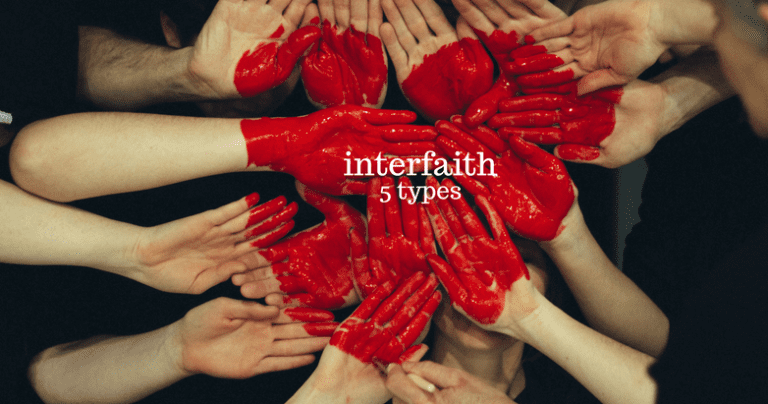
I have thought long and hard about what the term ‘interfaith’ means and how it is used in our society. Turns out, as is the case with many words and concepts, that it does not mean the same thing to all people. In fact, it is entirely possible that every time you say the word ‘interfaith’ someone will misunderstand you—even if you think that you are both talking about the same thing.
As my friend used to say, “misunderstanding is the most common form of understanding.”
To reduce the likelihood of such an occurrence, I have identified five types of interactions that fall under the heading of interfaith, each with distinct characteristics.
1) Small Religions Making Sure They Don’t Get Marginalized
Whenever a religion becomes isolated geographically or demographically, i.e. when it is in the minority, then interfaith efforts are important. The minority religion must work to allay reservations (if there are any), pre-empt or correct misunderstandings, and show that it provides value to the community.
It would be better if the small religions didn’t have to do any of that, if they were just accepted for their beliefs regardless, but that is not the world we live in, not even in Western liberal democracies (as has been made clear in recent years).
The minority religion, just like other minorities, is tasked with reaching out to others through interfaith endeavors, maintaining good relations, and creating goodwill.
2) Big Religions Showing Compassion
Thankfully, some larger religions understand their place and participate in interfaith events and endeavors out of compassion. Around the world, this is not always the case, and there are still countries that forbid the practice of other religions within their borders.
Here in the West, Christianity, which is still the largest religion, has shown tremendous compassion and churches have shared both resources and facilities with minority faiths in an attempt to create a strong community bond.
Of course, not all such interfaith interactions spring purely from compassion. Within a civil framework that values freedom of religion, the freedom to believe what you want depends on you honoring other people’s right to do the same. In such cases, interfaith may be practiced under the guise of mutually assured protection.
Whatever the reason, it touches an altruistic nerve within me when I see majority religions honor the rights of minority religions and consort with them openly.
3) Interfaith Action
In recent months, I have been in contact with a number of organizations who have the term ‘interfaith’ in their name, only to find out that they are primarily non-profit organizations serving communities on a number of fronts; helping the homeless population, refugees, the elderly, the poor, the hungry, and so on. These organizations put good works at the fore and for good reason. It’s a beautiful thing when people of different faiths work side-by-side to benefit their communities.
4) Open-Minded People Who Are Curious About Other Beliefs
The fourth type of interfaith is based on curiosity. An example of that is the New Age or self-help aisle in the bookstore. A number of bestsellers in those genres base their ideas on foreign faith traditions—especially Eastern mysticism. From the Dalai Lama to Deepak Chopra to Louise Hay and Wayne Dyer, many authors and speakers have tapped into a well of what Aldous Huxley called the perennial philosophy. According to sales numbers, curiosity about other beliefs and spiritual practices abounds.
Naturally, people can be curious for different reasons.
Believers, for example, can be curious about what others believe without actually wanting to change their beliefs at all. I, for one, honor those who do that. It takes a tremendous amount of confidence in one’s own faith to explore other traditions freely.
Spiritual seekers, on the other hand, who often call themselves spiritual-but-nonreligious, are open-minded for another reason. They are trying to piece together their own religious or spiritual philosophy, sometimes successfully, sometimes not (I will address this at a later time).
For most, though, open-mindedness is a blessing.
5) People Who Are Looking For Interspiritual Truths
I fall into this last category. From the time I can remember, I have been interested in interspiritual practices and philosophies. Being interested in interspirituality doesn’t mean that I think all religions are the same or even that they share the same message. Still, as Ken Wilber points out:
“…when you find a few essential items that all, or virtually all, of the world’s great religions agree on, you have probably found something incredibly important about the human condition.”
Interspirituality is not for everyone, but, for those of us who are interested, we have never lived in a better time to explore interspiritual practices. For the first time in history, we have easy access to all of the world’s scriptures and spiritual traditions.
Various Meanings of One Word
To recap, the five types of interfaith I have identified in this article are, (1) small religions that don’t want to be marginalized, (2) big religions showing compassion, (3) interfaith action organizations, (4) open-minded people who are curious, and (5) people who seek interspirituality.
I probably missed something, a category, a nuance, or even a type, so feel free to comment and share your thoughts on the subject.
Note that I intentionally focused on positive reasons to engage. I left out attempts to evangelize or convert under the guise of interfaith, both of which happen more than they ought to, and the political agenda of some interfaith organizations, both conservative and liberal.
With any luck, this contemplation will give you a better understanding of the various meanings of the term interfaith. From now on, you can, at the very least, ask what type of interfaith people are talking about when you come across the word in conversation.
In a later article, I will explore the four stages of interfaith communications, which differ slightly from the five aforementioned types.
Gudjon Bergmann
Author & Interfaith Minister
Visit Experifaith.org or read Experifaith: At the Heart of Every Religion to learn about a new approach to interfaith dialogue.
Picture: Pexels.com CC0 License














